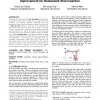Free Online Productivity Tools
i2Speak
i2Symbol
i2OCR
iTex2Img
iWeb2Print
iWeb2Shot
i2Type
iPdf2Split
iPdf2Merge
i2Bopomofo
i2Arabic
i2Style
i2Image
i2PDF
iLatex2Rtf
Sci2ools
ICCAD
2009
IEEE
2009
IEEE
How to consider shorts and guarantee yield rate improvement for redundant wire insertion
This paper accurately considers wire short defects and proposes an algorithm to guarantee IC chip yield rate improvement for redundant wire insertion. Without considering yield rate degradation caused by shorts, traditional methods may even lead to yield rate loss. However, shorts are more complicated to analyze than opens. Moreover, since any two points of a routed net can be connected by a redundant wire, the number of possible insertion patterns for a chip is un-tractable. To maximize yield rate improvement and to make the problem tractable, we identify a key insight, tolerance-ratio, as an effective guide for choosing insertion patterns and insertion order. Finally, to guarantee yield rate improvement , only positive gain redundant wires are committed. Experimental results show that, compared with unprocessed cases, all yield rate improvements in the proposed algorithm are positive, and the defect rates are reduced by up to 65% and by 24% on average. On the other hand, without con...
| Added | 18 Feb 2011 |
| Updated | 18 Feb 2011 |
| Type | Journal |
| Year | 2009 |
| Where | ICCAD |
| Authors | Fong-Yuan Chang, Ren-Song Tsay, Wai-Kei Mak |
Comments (0)

